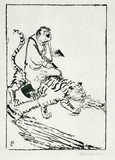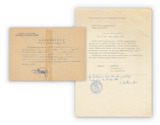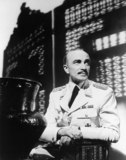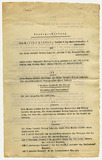Clément Moreau: La comedia humana/Nacht über Deutschland (1937/38), part 23 to 33
[Night over Germany] 107 Linocuts on Japanese tissue (gampi)
First published in Argentinisches Tageblatt and Argentina Libre, 1940A man in a black SS uniform and the skull emblem stands in the doorway of the prison cell. He hands the prisoner the rope: A rope with which to hang himself (figure 23).
Clément Moreau: La comedia humana/Nacht über Deutschland (1937/38), part 34 to 37
[Night over Germany] 107 Linocuts on Japanese tissue (gampi)
First published in Argentinisches Tageblatt and Argentina Libre, 1940These four cuts depict the wife and son of a prisoner. The individual cuts recall the Fürsorgeerziehung [corrective training] portfolio from 1929.
Clément Moreau: La comedia humana/Nacht über Deutschland (1937/38), part 38 to 52
[Night over Germany] 107 Linocuts on Japanese tissue (gampi)
First published in Argentinisches Tageblatt and Argentina Libre, 1940One of the men is just about to be released from prison (figure 39). Under his left arm he holds a bundle with his belongings.
Clément Moreau: La comedia humana/Nacht über Deutschland (1937/38), part 53 to 77
[Night over Germany] 107 Linocuts on Japanese tissue (gampi)
First published in Argentinisches Tageblatt and Argentina Libre, 1940Two male figures flee (figure 68). The second man is still in the unprotected glowing white; his long shadow extends diagonally across the picture.
Clément Moreau: La comedia humana/Nacht über Deutschland (1937/38), part 78 to 107
[Germany over Germany] 107 Linocuts on Japanese tissue (gampi)
First published in Argentinisches Tageblatt and Argentina Libre, 1940One of the men has succeeded in escaping (figure 78). With fearful facial expressions, balled fists and forceful movements, he is seen in the foreground of the block.
Clément Moreau: La comedia humana/Nacht über Deutschland (1937/38), part 9 to 22
[Night over Germany] 107 Linocuts on Japanese tissue (gampi)
First published in the newspapers Argentinisches Tageblatt and Argentinia LibreThe ninth linocut marks the beginning of ‘the interrogation’. The next cut shows a man being led into a glaringly lit, windowless room.
Clément Moreau: Wer auf einen Tiger reitet, kann nicht absteigen (1939)
Antifascist caricaturesUpon arrival in exile in Argentina, Clement Moreau became involved in the anti-fascist movement "Das andere Deutschland" ("The Other Germany"), and founded the cabaret and theatre group "Truppe 38" ("Troop 38"), which raised funds for anti-fascist work with its socially critical repertoire.As a caricaturist he also created hundreds of drawings which revealed the ridiculous nature of fascism and also unmasked its facade.
Confirmation of the deportation of Oskar Pastior, 22 June 1965
In January 1945, Red Army soldiers deported the 17-year-old Oskar Pastior to the Soviet Union. Members of the German minority in Romania were held co-responsible for the Second World War and had to do forced labour.
Conrad Veidt as Major Strasser in Casablanca (1942)
The Ufa star Conrad Veidt, who had left Germany out of moral conviction, going first to the UK in 1940, then into exile in Hollywood, met the same fate as many of his fellow actors. As a committed anti-fascist he had to play the German villain in American anti-Nazi productions.
Contract between Rowohlt Verlag and Mascha Kaléko (1934)
In preparation for publishing Little Reader for Grown-UpsFollowing the success of her first book The Lyrical Shorthand Pad, which appeared in January 1933 in the Berlin-based Rowohlt Verlag, the prestigious publisher was keen to secure the young poet Mascha Kaléko for future publications as well. For the follow-up Little Reader for the Grown-Ups, which went on sale in late 1934, she was able to negotiate markedly more favourable terms.
![Linocut: Clément Moreau: Nacht über Deutschland [Night over Germany] fig. 23 Linocut: Clément Moreau: Nacht über Deutschland [Night over Germany] fig. 23](/KIE/Content/EN/Images/objects/moreau-clement-nacht-ueber-deutschland-023-en.jpg?__blob=thumbnail&v=4)
![Linocut: Clément Moreau: Nacht über Deutschland [Night over Germany] fig. 23 Linocut: Clément Moreau: Nacht über Deutschland [Night over Germany] fig. 23](/KIE/Content/EN/Images/objects/moreau-clement-nacht-ueber-deutschland-023-en.jpg?__blob=thumbnail&v=4)
![Linocut: Clément Moreau: Nacht über Deutschland [Night over Germany] fig. 34 Linocut: Clément Moreau: Nacht über Deutschland [Night over Germany] fig. 34](/KIE/Content/EN/Images/objects/moreau-clement-nacht-ueber-deutschland-034-en.jpg?__blob=thumbnail&v=4)
![Linocut: Clément Moreau: Nacht über Deutschland [Night over Germany] fig. 38 Linocut: Clément Moreau: Nacht über Deutschland [Night over Germany] fig. 38](/KIE/Content/EN/Images/objects/moreau-clement-nacht-ueber-deutschland-038-en.jpg?__blob=thumbnail&v=4)
![Linocut: Clément Moreau: Nacht über Deutschland [Night over Germany] fig. 53 Linocut: Clément Moreau: Nacht über Deutschland [Night over Germany] fig. 53](/KIE/Content/EN/Images/objects/moreau-clement-nacht-ueber-deutschland-053-en.jpg?__blob=thumbnail&v=4)
![Linocut: Clément Moreau: Nacht über Deutschland [Night over Germany] fig. 78 Linocut: Clément Moreau: Nacht über Deutschland [Night over Germany] fig. 78](/KIE/Content/EN/Images/objects/moreau-clement-nacht-ueber-deutschland-078-en.jpg?__blob=thumbnail&v=5)
![Linocut: Clément Moreau: Nacht über Deutschland [Night over Germany] Fig. 9 Linocut: Clément Moreau: Nacht über Deutschland [Night over Germany] Fig. 9](/KIE/Content/EN/Images/objects/moreau-clement-nacht-ueber-deutschland-009-en.jpg?__blob=thumbnail&v=7)




